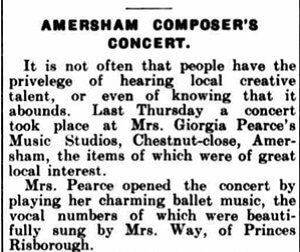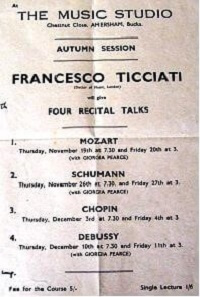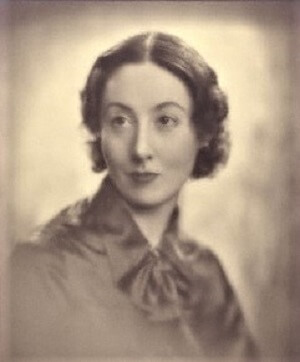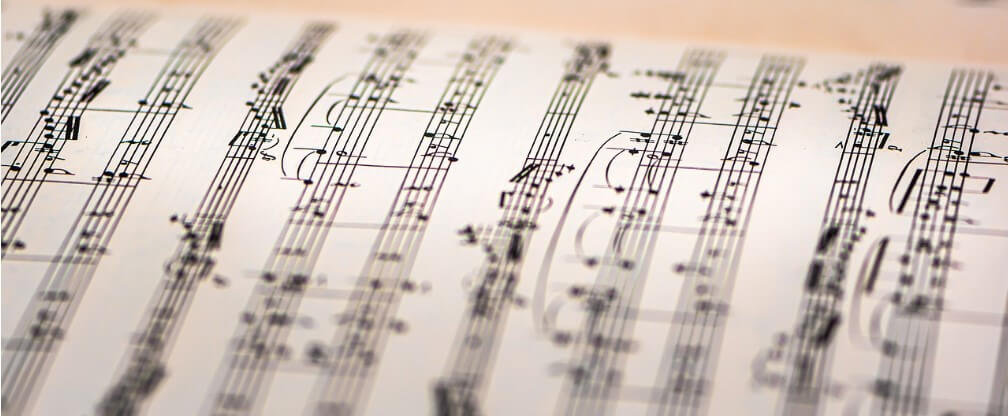When the “town swarmed with culture”
by Alison Bailey
Concert pianist Giorgia Pearce was a widow of 67 when she moved to Amersham and founded the Music Studio in 1936. This became an important meeting place for the cultured artistic community of London evacuees, particularly Hampstead intellectuals, and émigrés who lived in the town during the war. Francesco Ticciati, another professional musician, and composer, lodged at the Music Studio after fleeing Mussolini’s Italy. An Executive Producer at BBC Radio Music, Leo Black, later wrote about Ticciati’s time in Amersham: “for a man so besotted with England there could have been no more fortunate ‘fall on his feet’; the town swarmed with culture”.
Giorgia Pearce
Georgiana Wilkie Maria Hoby was born in Kensington in 1869. Her father was a librarian and publisher. When she was 27, she married 30-year-old Henry James Pearce. Soon after the birth of their daughter, Stella, the couple moved to Manchester where Henry ran the Clarion Café before opening his own bookshop in Market Street, which also became a meeting place for radical journalists and intellectuals. Both Henry and Giorgia were committed socialists, campaigned for women’s suffrage, and contributed articles to the labour movement’s Daily Herald. Giorgia taught singing, piano and music theory, gave concert performances, recitals, accompanied silent movies on the piano, and composed her own music.

Henry died in 1935 and Giorgia followed her daughter to London before settling in Amersham in 1936. Her friend, J L Garvin, the editor of the Observer, lived in Berkhamsted but she may have also been friends with sisters Sylvia Colenso and Irma Crovo at Elangeni, who were also suffrage campaigners and committed socialists. Giorgia’s first home here was in High Street where she founded the Music Studio with the intention of establishing an amateur opera society and small orchestra. The following year she moved to Chestnut Close in Amersham Common which had a large annex, with French windows, a loft and room for two pianos, making it perfect for a music room. Here she again offered music lessons and invited visiting teachers such as Hans Berge from Vienna, who taught violin. Classes in Natural Movement and Dancing were also offered to children and adults by Mary Evans. Ticciati later offered lessons in pianoforte and composition.
The Music Studio

Mabel Brailsford’s Wartime Diaries (published by Amersham Museum) describe how the Studio became a meeting place for musicians, writers, and intellectuals. Mabel, an accomplished pianist herself, describes the Music Studio as “changing her whole world”. She would make the journey from London Road, Old Amersham, to Chestnut Close, pushing her bicycle up Station Road and riding back in the black-out.
Visiting musicians and singers included Spanish violinist Angel Grande, Italian singer and pianist Manlio di Veroli (who later became famous for his training of Harry Secombe’s natural tenor voice) and the Czech mezzo-soprano Hendra Porges-Lilienfeld. Giorgia also organised fundraising concerts at the Free Church, St Leonard’s and Sally Latimer’s Playhouse. The Musicians’ Benevolent Fund was a favourite cause!
Artists living locally who performed at the Studio included violinist and pianist Constance Dupré who lived around the corner at Roslea, 23 Parkfield Avenue, Frieda Danziger, a classical singer, billeted at Flint House, Woodside Road and Ippolit Motchaloff, a concert pianist living in Great Missenden. May Page, the wife of Reverend Murray Page of Amersham Free Church frequently accompanied Giorgia on the second piano. Sylvia Colenso of Elengeni, another accomplished pianist was also a regular. She had earlier made the first known recording of the hymn Nkosi Sikelel iAfrika, now the South African National Anthem, with the African politician Sol T Plaatje, a founding member of the ANC, on vocals.
Lectures
A member of Louise Jopling’s, Chiltern Club of Arts, Giorgia also organised regular talks, play readings and musical lectures which Mabel described as “literary-philosophical-religious” meetings. Dr Ticciati gave a series of talks on composers such as Beethoven, Chopin, and Debussy. Mabel’s brother, the noted journalist and writer Noel Brailsford, gave a talk on “Gerrard Winstanley: The Light shining in Buckinghamshire”. Winstanley was a 17th century radical religious reformer who led the Digger movement which opposed land enclosure.
Norman Ierson Parley gave a talk on Great Cathedrals and what they express in 1941. Other talks were given by Father Milburn who lived at Durris, Stubbs Wood. He was an authority on Indian Scriptures, but his talk, in March 1942, was on his ideas of how religion should help to build the new world after the War. Marie- Louise von Motesiczky, and later Veza and Elias Canetti, lived with Father Milburn during the war. Canetti wrote about the Music Studio in his memoir Party in the Blitz.
Giorgia’s daughter Stella came often to the Studio and gave poetry recitals or lectures on the history of dress. In 1941, her husband, the journalist, art historian and art critic, Eric Newton, gave a talk on Compromise and in 1943 on Beauty.
Stella Mary Pearce

Giorgia’s daughter, Stella was a fashion designer and dress historian, who brought the history of fashion to bear on art history and the dating of paintings. She first acted with Frank Benson’s Shakespearean Company in London but moved to costume design after working as an assistant in the legendry Othello in which Paul Robeson and Peggy Ashcroft starred. She later designed for T. S. Eliot including his Murder in the Cathedral in Canterbury.
Stella opened her own shop, Stella Mary Pearce Ltd, Haute Couture in Bond Street. A developing expertise in the history of dress enabled her to re-date paintings through the evidence of clothing which led to her work as an adviser to the National Gallery. She later founded a postgraduate course in the History of Dress at the Courtauld Institute of Art. In 1976 Stella was awarded an OBE and was the subject of a 1992 documentary for Channel 4’s Third Wave.
Francesco Ticciati died at the Music Studio in 1949 when he was just 56 and Giorgia retired soon afterwards and moved to Angel, Islington to live with Stella and Eric. She died in 1963 at the age of 94.
If anyone has any information on Giorgia Pearce or the Music Studio, please contact us.
Sources
Wendy Tibbitts
Stella Mary Newton, nee Pearce (costumeconsultant.com)
Oxford Dictionary of National Biography
British Newspaper Archive
Ancestry
Stella Newton : London Remembers, Aiming to capture all memorials in London

